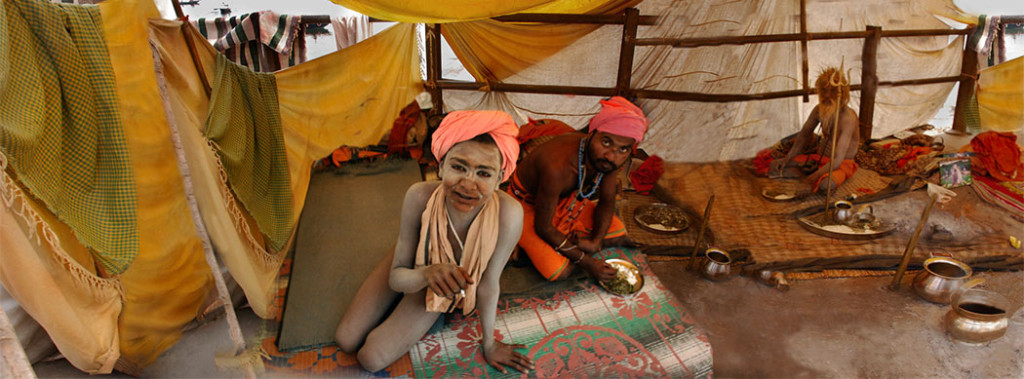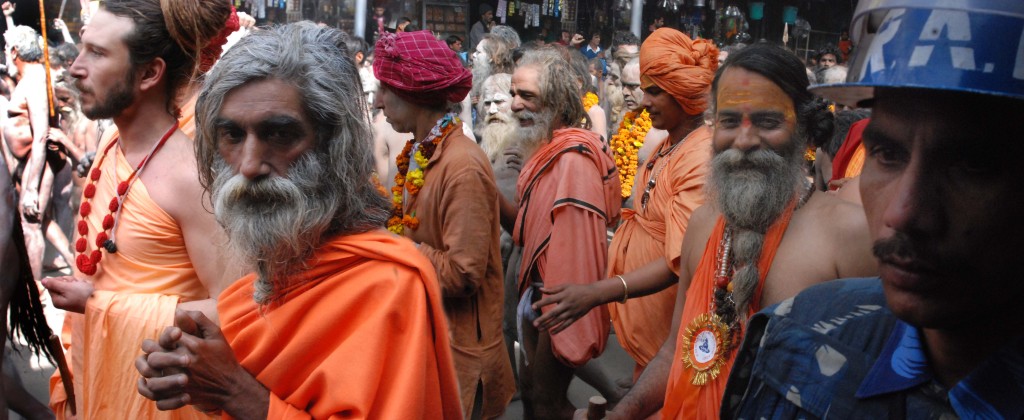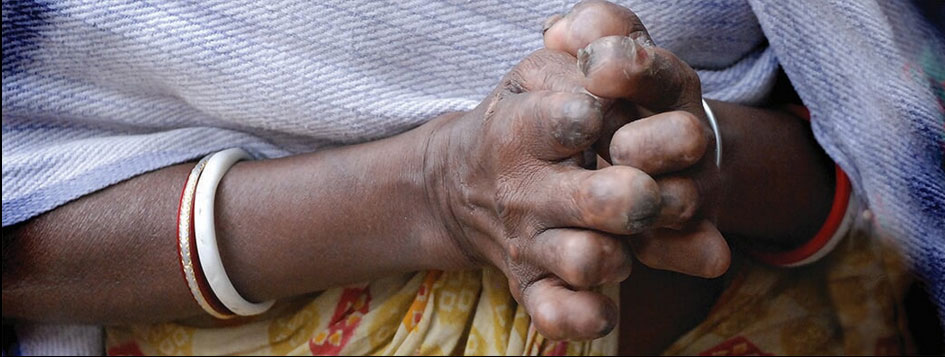Ganges Dawn
Predawn, everyone’s awake, Kashi’s jumping.
Excluding the homeless thousands who are unawake.
I’m walking cautiously to the ghats in the semi-dark through littered streets, trying to distinguish trash from cardboard and newspaper humps of low-castes sleeping, groaning while sleeping.
Do they dream while they sleep?
Is it a collective dream?
Has their 2000 years of servitude infected their dreams?
Can ideology, if caste consciousness may be called that, imprison dream, arguably the only uncolonized space left?
Yes, it can. Even as the sleek white Mercedes bulldozes the rickshaw off the road and the rickshaw wallah accepts the aggression as his due, absolutely without resentment.
Cremation-white smoke curling, the ghats are alive.
I’m led down steep stone steps to the primary burning ghat: Manikarnika, whose motto is: There is never a moment when a corpse is not aflame in Manikarnika.
I read that on a postcard for tourists.
Another card in the same set has a photogenic, photoshopped army of “warrior priests,” Shiva worshippers, muscular ganja smokers, naked, smeared with ash, holding hands in dreamspace, en route to the dream within a dream.
Edgar Allan Poe’s phrase.
Poe, forever isolated, felt too much, it killed him, I admire him even more since coming to Kashi.
Dim light in the eastern smog: dawn closing in.
On one of the steep steps, death smoke rising, leading down to the river, a macaque monkey family of 7 or 8 is calmly grooming, picking fleas.
Hindu devotees step around them.
I’m in a flimsy rowboat moving northwest, trying to keep from getting splashed, sun not yet visible.
I’m sharing the boat with a rat snuggled into the port side.
I thought the rat was a goner but saw the long tail jerk.
The rower is a slender teenage low caste-barefoot boy chewing betel, spitting into a small basin by his feet.
He points to a crumbling palatial structure looming over Manikarnika Ghat.
Maharajah of Jaipur own, he says.
Why not? Maharajah gazes at death.
Royal get-away-from-it-all.
Bathers and washers are in the shallows, scrubbing and grooming each other.
Brahmins with sacred threads, not just Brahmins, both genders, near naked, middle-aged, older, gargling the sacred water filled with ash, body parts, dogs, dead sacred cattle.
White smoke rising.
Crows and Siberian gulls circling.
No vultures oddly.
Other small row boats pull alongside, low-caste women selling sweets, trinkets, postcards.
I buy a card set featuring the digitally altered warrior priests for 50 rupees.
My boat wallah and other boat wallahs shouting to each other in Hindi.
Shouting, plash of oar, bird caws, crackling corpse fires, sacred chanting—the sounds break apart into a white noise.
Silence.
Starboard over my right shoulder finessing through the smog, finally a bit of gold.
And here come the mosquitos, I forgot my DEET, hope they’re not dengue.
The rat twitches its tail.
Good, we’re in this together.
Suddenly a black myna, related to the starling, lands on the prow and stares at me with its keen black eye.
The young boat wallah turns and whispers to me hoarsely, with feeling:
There, sir, the sun!
Even as I see the golden disc.
Sacred Geography
I give the beggar-sadhu in his tattered saffron dhoti with open sores on his arms a 50-rupee note.
He is barefoot; he turns and pads away toward another tourist.
His is not a sacred begging performed in imitation of the ascetic Lord Shiva.
The Varanasi sadhus who live in and around the burning ghats bordering the Ganges are impoverished and neglected.
They are in no way impressive: broken down, sickly, sometimes plainly—not divinely—mad.
Forty-five years ago, a blip sometimes called The Age of Aquarius—embedded in the cruel overarching Age of Kali—transpired.
It coincided with hallucinogens, which enabled many seekers to witness different landscapes.
Interiority, dreamspace, what may be called sacred geography, became intimately familiar.
Young people meditated, read visionary writings, traveled east to Asia and south to Central and South America to inhabit the sacred geography at its source.
East Indian sadhus and yogis were at a premium.
Forty-five years later, for intricate reasons, technology has supplanted dream.
Digital geography has supplanted sacred geography.
Algorithm has supplanted Intuition.
Contemporary young people tend to travel with their fingers.
What Paul Virilio calls “motility” instead of mobility.
We access the harshest, grandest catastrophes on our miniature smart receptors, where they merge with insipid social media.
Can digital and sacred geography coexist?
With difficulty.
Planet Earth is perishing, digital and sacred geography will or won’t coexist for the duration.
Cruelty will continue to dominate.
Death is our heart’s mother.
Turban
He sat next to me in the densely crowded Delhi airport terminal.
I was reading with some irritation a typically over-ornamented Thomas Mann long short story.
I smelled him before I saw him—a curious odor—stale, dry, camphor-like.
As though he just retrieved his garments from a lengthy seclusion in the closet.
He sat to my left and I partially turned to him.
He was a Sikh, with the traces of a black-grey beard, a big man wearing a black turban and steel bracelet, 2 of the so-called 5 Ks enjoined on all Sikh males.
In Punjabi the 5 Ks are Kesh, Kanga, Kara, Kachhera, Kirpan.
Which is to say: uncut hair and beard, wooden comb, steel bracelet, cotton underwear reflective of modesty, and a small sword to be used solely in self-defense and in protection of the needy.
The turban is to keep the uncut hair in place.
The camphor odor appeared to issue from the turban.
I retrieved from memory the ensuing narrative.
In October 1984 Prime Minister Indira Gandhi, prideful Nehru’s prideful daughter, was shot to death by two of her trusted Sikh guards.
In the bloody aftermath, Hindu supporters of Indira Gandhi brutally murdered up to 12,000 Sikhs, in many instances amputating their legs, then burning them alive.
The immediate reason for Gandhi’s assassination was her violent response to a Sikh secession initiative in the Punjab area in northwest India.
Specifically, the Indian army’s so-called Operation Blue Star, in June 1984, assaulted and badly damaged the sanctified Golden Temple in the sacred Sikh city of Amritsar.
Many Sikhs felt and currently feel that they occupy an anomalous, unrespected position in India, especially among the Hindu majority, but also among the Muslims.
On the other hand Sikhs are India’s principal warriors who have long been depended on to lead wars against Pakistan, Afghanistan, and in Jammu-Kashmir.
During the Raj they served as colonizing Britain’s chief defenders of the faith.
In the aftermath of Indira Gandhi’s assassination and the large scale Hindu bloodletting, Sikhs went into hiding and/or disguised themselves, many of the males shaving their hair and beards.
I remember travelling in western Europe in the late eighties and meeting Sikh males, especially restaurant owners and workers, who were unidentifable but for their steel bracelet, which represents their unbreakable bond with God.
It is thirty-plus years after the assassination, the Sikhs have still not seceded, but the history of the assassination and its bloody aftermath have distanced themselves into a kind of archeology.
Which is the way it happens.
Sikh males are regrowing their hair and beard and removing their turban from its storage area in the closet.
Beat Hindu
Rereading Allen Ginsberg’s Indian Journals.
With his reticent longtime Harpo Marx lookalike lover Peter Orlovsky, Ginsberg spent nearly two years in India in the early 60s, much of it in Kashi and Bengal.
He inscribed that sequence in a delirious prose-poetry filled with misspellings and awkward grammar to convey immediacy and zero editing.
At one juncture Ginsberg and Orlovsky were arrested as vagrants; the Kashi police asked for their papers.
“What is it about India that you like so much?” one of the baffled cops asked him.
Ginsberg “liked” the corpses cremated in the burning ghats, describing the process in grisly detail, snapping photos of severed corpse fingers and feet.
Ginsberg liked the sacred cows that wandered around the burning ghats at midnight eating “the rush ropes left behind on the sand near the woodpiles on which corpses wrapped in white cloth are cremated.”
He liked to shit his dysentery into the holy Ganga.
He liked to detail graphic sex-play with Orlovsky while both were suffering with dysentery and tropical illness.
He liked to shriek back at old beggar-women.
He liked to feed bananas to monkeys.
He liked—was irresistibly drawn to—the squalor.
Already notorious for Howl and Kaddish, Ginsberg was a hell-bent motherfucker in his late thirties who didn’t stop doping.
Opium, morphine, heroin, bhang, hashish, atropine.
Swallowing, shooting, hanging with wacked-out Aghori sadhus who doped with him.
He described dreaming while on and off the dope, dreams contradicting or merging with whatever the “reality” was / is of Kashi.
Always compulsively extroverted, Ginsberg referred constantly to his “Beat” mates: “blowing Jack” [Kerouac], writing to Burroughs, Snyder and Corso, fantasizing sexually about Neal Cassady.
Referred to visionary poets like Blake, Whitman, Rimbaud, Dylan Thomas, who in crucial ways seemed to Ginsberg versions of the ancient Indian poet Kabir: holy Hindus.
What Ginsberg was finally doing in his shamanic kamikaze way was seeking that luminous vibrating inner void, celestial white noise, eternal mandala, beneath, between, within the lepers, untouchables, malformed, burnt corpses, squalid mania.
Did he find it?
Mother
The girl is 18 when she leaves her village in Yugoslavia for Ireland, there to attempt to join the order of Loreto, nuns who work among the poor and dying in India.
She got the idea of India from a series of letters a Yugoslav priest stationed in Calcutta wrote, excerpts of which were published in Serbo-Croatian in a weekly newspaper.
What was she feeling when she undertook the arduous trip from Skoplje to Dublin?
She spoke Albanian and Serbo-Croatian but could not utter a sentence of English.
It marked the first time she had left her rural village.
She recited her rosary, but what of the cold, the discomfort, the extraordinary strangeness, the arduous weeks of the voyage, overland then by sea?
She arrived in Dublin, made herself understood sufficiently to impress, be admitted to the order of Loreto.
The following year, in accord with her wish, she was sent to India to work among the poor and dying.
I’d like, respectfully, to gain entrance to the range of feelings she was experiencing when she made her arduous journey from Skoplje to Dublin.
When she was admitted to the order of Loreto.
When she slept that first night among the sisters of Loreto.
Named Agnes Bojaxhiu, the Ethnic Albanian girl leaves Yugoslavia for Dublin, Ireland, to attempt to join the order of Loreto, nuns who minister to the poor and dying in India.
She is admitted and the next year is sent to India, though to Darjeeling, in the Himalayan foothills, rather than to Calcutta.
When she leaves Skoplje for the very long and arduous trip to
Dublin, what does the eighteen-year-old pack in her small suitcase?
How, en route, does she wash and dry her single change of linen?
When under the harsh conditions she manages a few hours of sleep, does she dream?
I’d like—with respect—to inhabit that dream.
Agnes Bojaxhiu arrives in India and travels to Darjeeling, the British-styled hill station, where she takes vows of poverty, chastity, obedience.
After two years she is transferred to Calcutta.
She learns Bengali rapidly.
She has already learned Hindi.
She tends to the poor and the dying.
After seven more years she applies to the Holy See for permission to live outside the Loreto convent.
Permission is granted and she devotes her entire time to ministering to the poor and dying.
That she later becomes world-famous is an anomaly.
She publicizes her work not because of her lust for fame, but because she needs rupees.
More resources to minister to the poor and dying.
There are never enough rupees.
Ganges Water Parcel
Were I to collect Ganges River water into a parcel, bind it then mail it, what then?
Would I be able to capture the water to package and bind?
To whom would I send the Ganges parcel?
What would the recipient think when opening the parcel and having the water pour into his/her lap?
Would it matter that the water in his/her lap were from the sacred River Ganges?
Would the recipient feel that suddenly soaked below the waist in Ganges water was a blessing?
How would the recipient know the source of the water?
That, for example, it wasn’t Yangtze River water.
Attaching an identifying note to the parcel would seem to defeat the purpose.
What purpose?
Conferring grace.
How can one confer grace without possessing grace?
Why would attaching a note be inimical to conferring grace?
How important is it to know the “answers” to these questions?
Is it not the gesture that vibrates?
For the gesture to vibrate wouldn’t the recipient have to respond intuitively?
Can someone not intuitive become intuitive when receiving a Ganges water parcel which when opened pours into his/her lap?
Does intuitive here mean visionary?
Is it possible that Ganges water delivered in that fashion can turn the non-visionary recipient into a visionary recipient, a satori response?
Satori comes, if at all, after long practice.
Is long practice obligatory?
Someone has a “near-death” experience and is changed instantly without prior practice.
Changed how?
For how long?
For a minute. A year. A lifetime.
Does it matter?
Transience is transience.
Now especially when we count Planet Earth’s remaining viable years on our fingers and toes.
Kali yuga.
Who has theorized it more precisely than the Hindus who worship the Ganges?
I wouldn’t call Hindu theorizing precise. Or consistent.
Nor, at this dying juncture, would I put much stock in what you call visionary.
I will suspend disbelief.
Say it again.
Were I to collect Ganges River water into a parcel, bind it then mail it, what then?
Untouch
They are blackened. Barefoot. Thin as reeds.
Your untouchables.
—You are not Hindu. You know nothing.
I see them clean your privies, quarry rocks, balance the burning upper-caste corpse on the bier with long bamboo poles.
—You imagine seeing. You are not Hindu. You see nothing.
Near the burning ghat, the shrunken untouchable woman folded like a child on the pocked stone, eyes closed, her blackened child’s arm extended clasping the small tin pail for alms.
—You are a sentimentalist. You impose your imaginings.
Your Hindu devotion is an opiate.
The rupees you spend on festivals to Lord Shiva and to your promiscuous boy-god Kishna should be distributed to the untouchables.
The rupees you spend on savaging trees for your high-caste cremations into the Ganges should be distributed to your untouchables.
—You are perilously close to blasphemy. Step back.
You take refuge behind the alleged mysteries of Hinduism.
There is no mystery about untouchable children born tormented.
That cruelty cannot be obscured, relativized, buried in Hindu sacrament.
—You are non-Hindu. You see with uncleansed eyes.
You conveniently confuse your religious laws, designed to promote your own high-caste interests, with justice to the imposed, invisible underclass.
—Not at all. You are not Gulliver among the Yahoos. You are a do-gooder non-Hindu dabbler in a culture you cannot comprehend.
Liberation, nirvana, moksha.
How do you attain liberation from samsara in a culture predicated on slavery?
—You make a privileged tourist’s observation. You are incapable of seeing with the spirit-eye.
Your untouchable suffers silently.
He services you almost ceaselessly.
When he doesn’t service you he is invisible.
If he protests you efface him.
These are humans not vermin.
—You are blaspheming. You are a privileged caucasian do-gooder, but you are not outside the law.
Apprehend me.
Put me in chains.
—You are an egotist with a martyr’s complex.
Your expressed willingness to sacrifice has to do with yourself not with so-called untouchables.
Joan of Arc is a western not a Hindu conceit.
Ganges Dusk
Wake up to drums and loud chanting.
6:20 AM. Is it a dream?
Here one wakes from dream into dream.
Every other day is a holy day in Kashi.
Another devotional festival.
Today is Dev Diwali.
But didn’t we celebrate Diwali, Festival of Lights, just a few days ago?
That Diwali was devoted to the goddess Lakshmi, Lord Vishnu’s consort.
Dev Diwali is devoted to Lord Shiva’s victory over the demon Tripurasur.
On Dev Diwali, which always coincides with a full moon, devotees take a bath and/or a boat ride in the Ganga, light oil lamps, called Diyas, do puja, set off fireworks, and make lots of noise.
Devotional noise.
When the sun sets, the steps of all the ghats and temples are alight with Diyas, millions of them.
Millions?
Yes. Everything becomes exponential in India.
It is Dev Diwali, full moon, and I’m in an old open boat on the sacred Ganga.
As soon as the moon comes up in the east through the mist the drums get to romping and the oil lamps are lit on each of the 87 ghats from south to north.
Everywhere is elaborately patterned bright light.
Except for the two burning ghats which continue cremating corpses, smoke curling over the Ganga.
Fire and water are the two dominant elements for devotional Hindus.
The east where the moon rises is composed of a single sandbar, construction prohibited because it would interfere with viewing the the sunrise.
The Mughals ruled India for nearly 200 years, did not worship the Ganga, and razed most of the ancient temples and other Hindu structures on the western ghats.
It is a surprise that they did not erect their own structures on the wide empty sandbar.
The moon is full.
Chanting, music, fireworks, millions of oil lamps and a million or more souls on each of the 87 ghats raucously celebrating.
Though Lord Shiva is nominally the subject of Dev Diwali, I do not hear his name invoked in the chants.
I think of carnival among the impoverished, in the Brazil favelas for example.
A week of sensual-samba-masquerade-mania a year, then back to shitty bad-paying work, or no work.
In the holy Hindu city of Kashi, the carnival (without the sensuality of course) goes on throughout the year, so that devotion is turned into an opiate which keeps the millions of impoverished and low-castes perpetually celebrating.
Then they go home to squalor.
I notice how many of the poor celebrants snap photos with their mobile, fulfilling the Prime Minister’s extravagant lunacy of elevating the afterimage in the process of digitalizing India.
Harold Jaffe is the author of 25 volumes of fiction, docufiction, and non-fiction, including: Death Café; Revolutionary Brain; Induced Coma; Anti-Twitter: 150 50-Word Stories; Paris 60; Jesus Coyote; 15 Serial Killers; Beyond the Techno-Cave; Terror-dot-Gov; Straight Razor; Eros Anti-Eros; False Positive; Beasts; Mourning Crazy Horse; Madonna & Other Spectacles; and Dos Indios. Jaffe’s writing has been translated in Turkey, France, Spain, Romania, Japan, Italy, and Cuba. He is editor-in-chief of Fiction International.
Photographs by Catherine Jansen








